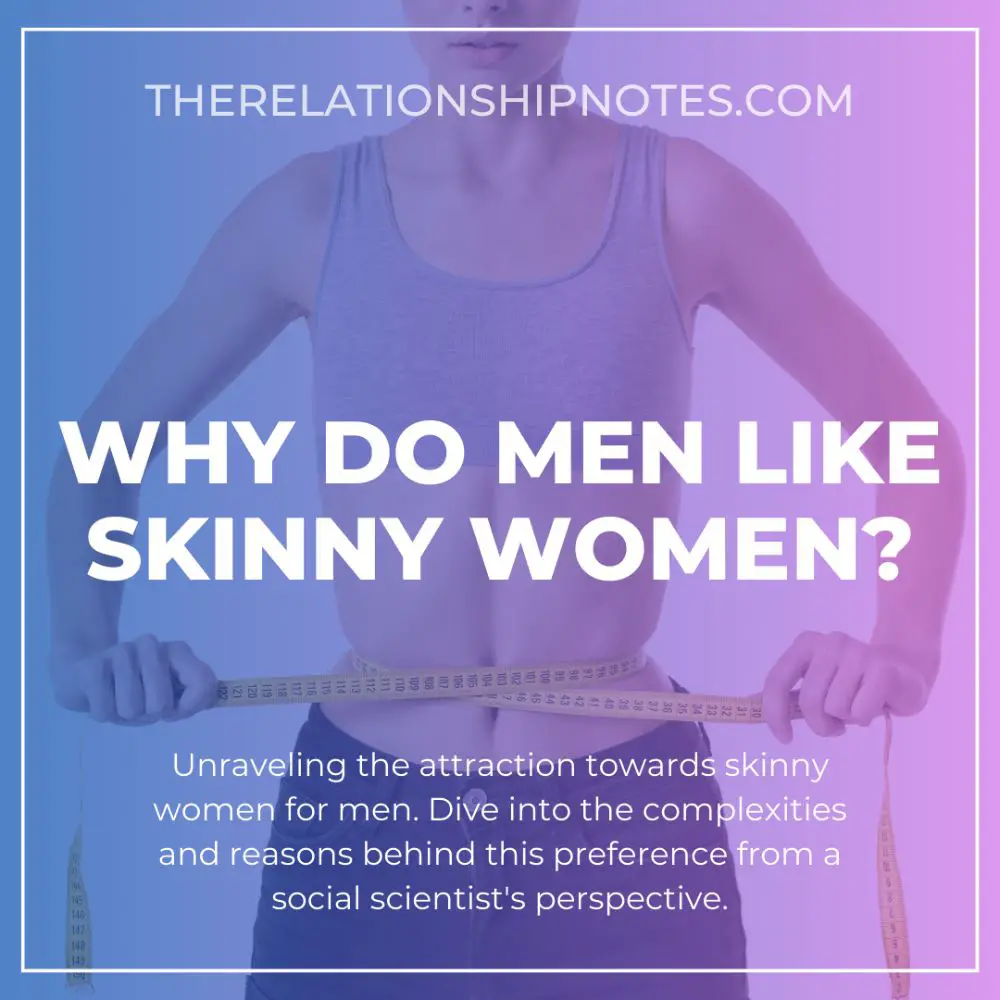Why do men find skinny women attractive?
Table of Contents
This question has been asked by many, but the answer is not so clear-cut.
As a social scientist, it is important to explore this phenomenon and understand the underlying reasons why some men prefer thinner partners.
One possible explanation for this preference could be attributed to societal norms and media portrayal of thinness as an ideal body type.
From fashion runways to Hollywood movies, thinness is often equated with beauty and desirability.
Men may internalize these messages and associate skinniness with attractiveness, leading them to seek out slender partners.
However, it’s important to note that not all cultures value thinness in the same way, and there are also variations within societies based on personal preferences and experiences.
Therefore, further research is needed to fully comprehend why certain men are drawn toward slimmer women.
Summary
- Societal norms and media portrayal of thinness as an ideal body type contribute to men’s preference for skinny women.
- Gender stereotypes and beauty standards shape our perceptions of attractiveness and influence the preference for thinner partners.
- Advertising and marketing campaigns perpetuate unrealistic beauty standards and influence men’s perceptions of attractiveness.
- Body image and self-esteem are important factors that impact men’s preferences for skinny women.
- Evolutionary psychology suggests that men may be attracted to slender women due to subconscious associations with reproductive fitness. However, personal preferences and cultural values also play a significant role in attraction.
1. The Cultural Context Of Attractiveness
Gender stereotypes and beauty standards have long been intertwined in our society.
Women are expected to be thin, beautiful, and youthful while men are supposed to be strong, muscular, and tall.
These gendered expectations shape not only how we view ourselves but also impact the way we perceive others.
Skinny women have often been viewed as the epitome of feminine beauty.
This perception has been reinforced by popular culture – from fashion models to actresses – who embody this idealized image.
As a result, many women feel pressure to conform to these standards at all costs, leading some individuals down dark paths toward eating disorders or other health complications.
Men may prefer skinny women because they believe that it is what is socially acceptable or desirable based on cultural norms.
However, this preference does not necessarily reflect everyone’s opinion nor should it dictate one’s self-worth.
It is important for us to recognize and challenge these societal pressures so that we can create more inclusive definitions of beauty that celebrate diversity rather than perpetuate harmful stereotypes.
More Articles:
Reasons Why Do Men Like Doggy Style
2. Societal Norms And Media Influence
The cultural context of attractiveness is undoubtedly complex and multifaceted.
One aspect that cannot be ignored, however, is the influence of societal norms and media on beauty standards.
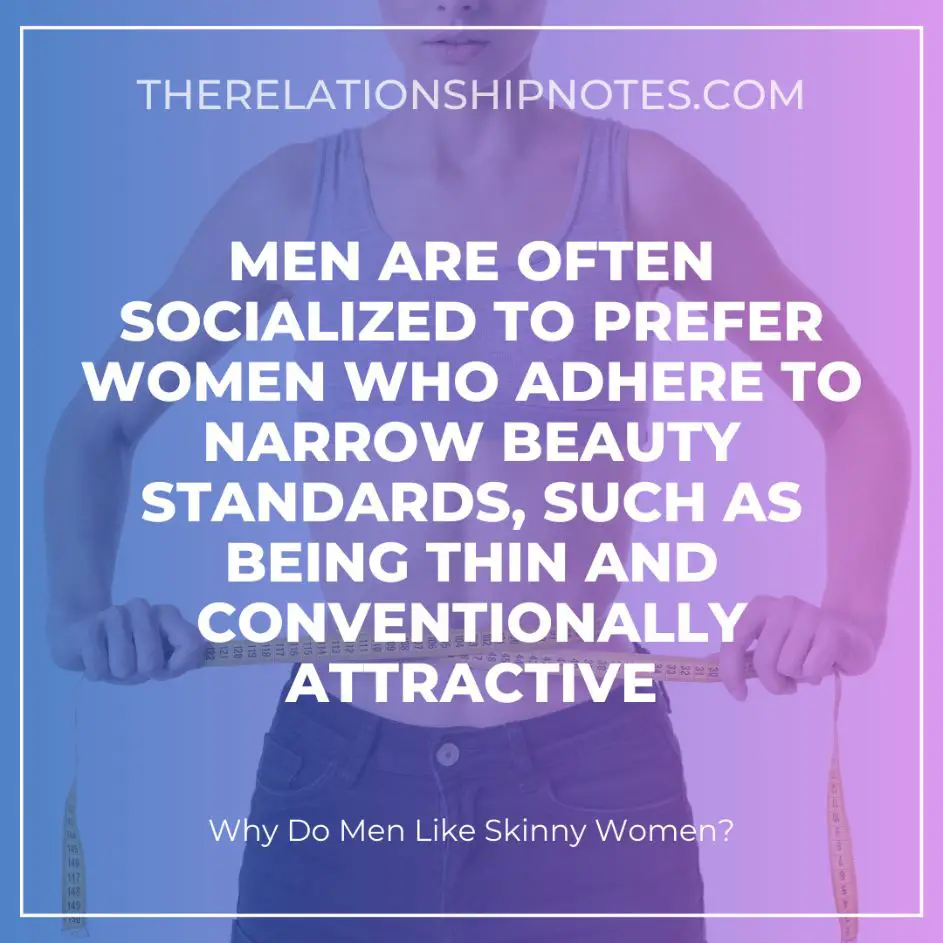
These factors shape our perceptions of what is desirable in a partner or mate.
Gender expectations play an important role in shaping these cultural ideals.
Men are often socialized to prefer women who adhere to narrow beauty standards, such as being thin and conventionally attractive.
This can have detrimental effects on women’s self-esteem and body image, as well as contribute to unhealthy behaviors like disordered eating.
It’s crucial for society to recognize the harm caused by rigid beauty standards and gender expectations.
Dismantling these harmful beliefs requires ongoing efforts from individuals, institutions, and media outlets alike.
Only then can we create a more inclusive and accepting culture where people of all shapes and sizes are valued for who they are rather than their appearance alone.
3. The Impact Of Advertising And Marketing
It is a common belief that men prefer skinny women over curvier ones.
This perception has been reinforced by advertising and marketing campaigns, which often promote unrealistic beauty standards.
These messages can have a significant impact on how individuals view themselves and others.
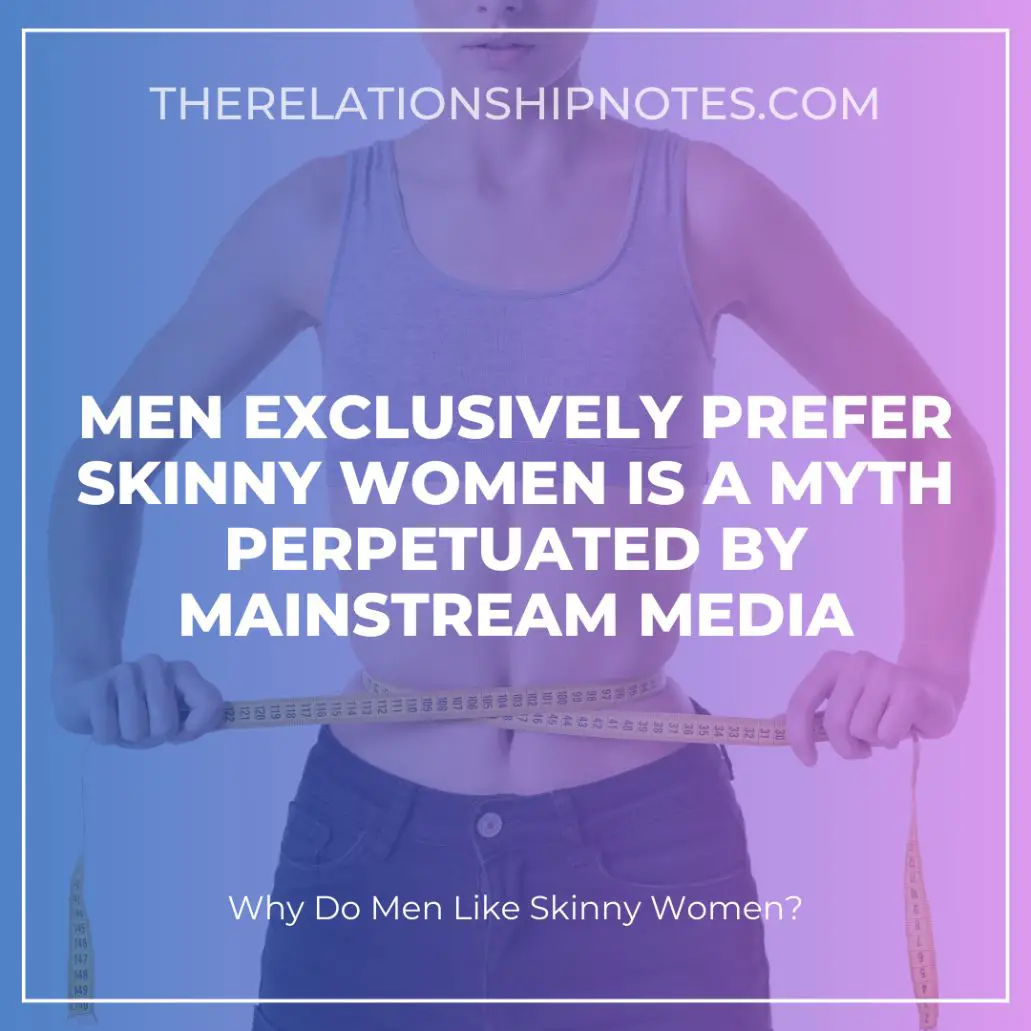
Body positivity movements aim to challenge these narrow conceptions of beauty and encourage people to embrace their natural bodies.
Such initiatives seek to create more inclusive representations in media and other forms of communication.
By celebrating diversity, they hope to combat the negative effects of body shaming and promote greater self-esteem among all individuals.
However, it is important to acknowledge that changing deeply ingrained societal norms takes time.
While progress has been made toward promoting healthier attitudes about body image, there are still many challenges ahead.
It will take continued efforts from activists, researchers, and everyday citizens alike to build a culture where everyone feels valued regardless of their appearance.
- Beauty standards are not fixed but rather shaped by cultural norms.
- Advertising can perpetuate harmful stereotypes about what constitutes an attractive body type.
- Body positivity movements provide an alternative perspective that promotes acceptance and inclusivity.
In conclusion, the notion that men exclusively prefer skinny women is a myth perpetuated by mainstream media.
There is no one-size-fits-all standard for attractiveness or desirability – such perceptions are subjective and influenced by various factors including personal preferences and cultural values.
To break free from restrictive beauty ideals, we must continue spreading awareness about body positivity while working towards creating more diverse representation across various mediums.
4. Body Image And Self-Esteem
Many men may have a preference for skinny women due to societal pressure and beauty standards.
However, this preference is not universal and should not be taken as the sole determinant of attractiveness or worth.
Body positivity movements have gained traction in recent years, promoting self-love and acceptance regardless of size or shape.
These campaigns aim to combat harmful messages that perpetuate narrow beauty ideals, which can negatively impact individuals’ self-esteem and mental health.
It’s important to recognize that everyone has their unique physical attributes, and there is no one-size-fits-all when it comes to beauty.
Instead of focusing on arbitrary standards, we should celebrate diversity and encourage body positivity in ourselves and others.
By doing so, we can promote healthier attitudes toward our bodies while challenging harmful societal pressures.
5. The Role Of Evolutionary Psychology
Evolutionary psychology suggests that physical attraction plays an important role in mate selection.
An individual’s preference for a particular body type could be influenced by evolutionary adaptation and sexual selection.

Therefore, it is possible that men are attracted to slender women because of factors related to reproduction.
One explanation for why men may prefer skinny women is the idea of reproductive fitness.
Evolutionarily, individuals who possess traits that make them more likely to survive and reproduce will pass on those traits to their offspring.
In this context, being thin could indicate good health and fertility.
Men who are subconsciously drawn to thinner women may be seeking out partners who have a higher likelihood of producing healthy children.
Another hypothesis is based on cultural norms and media representation.
Historically, society has placed value on slenderness as a desirable trait in women.
The media often portrays thinness as the ideal body type for females, leading some men to internalize these ideals when looking for a partner.
This socialization process can create gender-specific preferences around beauty standards which shape an individual’s perception of attractiveness.
It is important to note that not all men prefer skinny women, nor should they feel pressured to do so due to societal expectations or perceived evolutionary pressures.
Attraction is multifaceted and varies from person to person based on personal experiences and individual preferences.
Ultimately, understanding the role of evolution in shaping our perceptions of attractiveness can provide insight into how we choose romantic partners but does not dictate whom we should find attractive or pursue relationships with.
6. Physical Health And Fitness
Physical Health and Fitness are essential components of a healthy lifestyle.
Men’s preference for skinny women may be related to the perception that thinness signifies physical fitness, which is often associated with health.
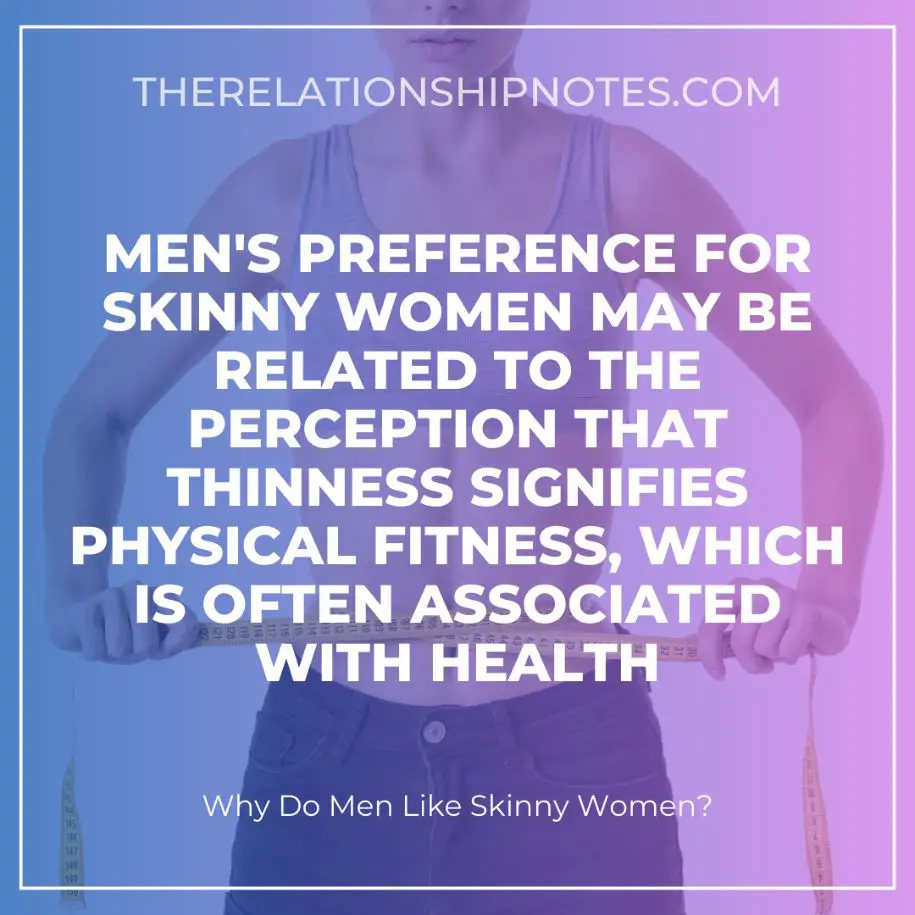
However, it should be noted that being thin does not necessarily mean a person is physically fit or has healthy habits.
To maintain good physical health, individuals must engage in regular exercise and follow proper nutrition guidelines.
Healthy Habits such as eating a balanced diet, getting enough sleep, avoiding smoking, and excessive drinking can improve overall well-being.
Moreover, incorporating strength training into one’s workout routine can help build muscle mass while reducing body fat percentage.
Fitness Fads come and go but focusing on sustainable routines like yoga, Pilates, or HIIT workouts may lead to long-term success in weight management and improved physical health.
It is important to remember that there is no ‘one size fits all’ approach to health and wellness.
Therefore, finding an activity that brings joy and fulfillment can increase motivation to continue exercising regularly.
In summary, men’s attraction towards skinny women could stem from the association between thinness and physical fitness derived from cultural norms.
However, maintaining excellent physical health involves more than just being slim; it requires adopting healthy habits such as regular exercise and following proper nutrition guidelines.
Finally, by embracing sustainable fitness fads and finding activities enjoyable helps create long-term adherence to a healthy lifestyle.
7. Personality Traits And Compatibility
As we have explored in the previous section, physical health, and fitness are important factors that influence our preferences for romantic partners.
However, these factors alone do not determine compatibility and emotional connection between two individuals.
When it comes to lasting relationships, personal values and beliefs play a crucial role in determining whether two people are compatible with each other.
While physical attraction may be one aspect of initial attraction, shared values such as honesty, trustworthiness, and empathy can foster deeper emotional connections over time.
In fact, research has shown that couples who share similar values tend to experience higher levels of relationship satisfaction and overall happiness.
This suggests that while physical appearance may initially catch someone’s eye, it is ultimately an individual’s personality traits and core beliefs that form the foundation of a successful long-term relationship.
8. Social Status And Power Dynamics
It is commonly believed that men are attracted to skinny women due to societal gender stereotypes and beauty standards.
These expectations have been perpetuated by media representations of ideal feminine bodies, which often feature slim figures with narrow waists and toned abs.
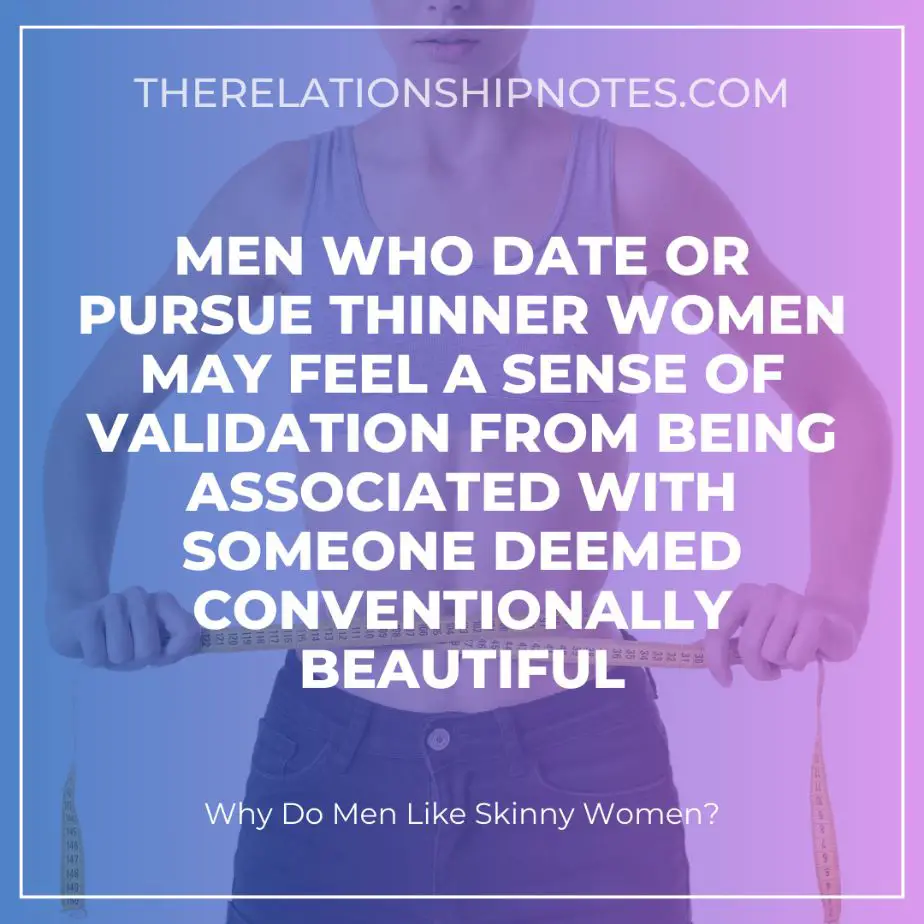
In this way, the socially constructed idea of what it means to be attractive has created a preference for thinness among men.
However, there may also be deeper power dynamics at play in why some men prefer skinny partners.
Research suggests that individuals who conform to traditional beauty standards are seen as more desirable and successful, leading them to hold greater social status than those who do not fit these molds.
As such, men who date or pursue thinner women may feel a sense of validation from being associated with someone deemed conventionally beautiful.
Moreover, it is worth noting that body size preferences can vary across different cultures and time periods.
For instance, during the Renaissance era, fuller-figured women were considered highly desirable due to their association with wealth and fertility.
Therefore, while societal expectations undoubtedly influence individual preferences when it comes to physical appearance, these norms are not fixed or universal.
It is essential to recognize how cultural contexts shape our ideas about attractiveness and question why certain ideals persist over time.
Numeric List:
Here are three ways in which gender stereotypes and beauty standards intersect:
- Women who adhere to conventional beauty standards tend to enjoy higher social status.
- Men’s attraction toward skinniness may stem from a desire to validate their own social standing.
- Ideal body types evolve over time based on broader cultural trends and historical contexts.
As such, we must consider multiple factors when examining why men might express a preference for skinny women rather than relying solely on surface-level assumptions about personal taste or biology.
By exploring the complex interplay between social norms and individual psychology, we can better understand how power dynamics manifest in romantic relationships and work towards creating a more inclusive society where diverse body types are celebrated.
9. Media Representation And Diversity
Body positivity and intersectional feminism have been movements gaining momentum in recent years.
These concepts challenge the narrow beauty standards set by the media, which often include only one body type – thinness.
The glorification of skinny women perpetuated by the media can be traced back to the fashion industry’s preference for models with smaller frames.
This has resulted in a culture where being thin is equated with success and desirability.
However, this representation ignores the diverse range of bodies that exist outside of those deemed “acceptable” by society.
It fails to take into account factors such as genetics, health conditions, cultural backgrounds, and personal preferences that contribute to an individual’s physical appearance.
Body positivity aims to promote self-love regardless of size or shape while intersectional feminism recognizes how different forms of oppression intersect and impact individuals uniquely.
Therefore, it is essential to shift away from singular representations of beauty towards embracing diversity across all areas of life.
Encouraging inclusivity in media representation would help reduce harmful stereotypes surrounding specific body types and create safe spaces for people who do not fit conventional beauty norms.
Promoting intersectional feminism alongside body positivity would also encourage meaningful conversations about why certain bodies are privileged over others and what steps we can take toward creating a more equitable world for everyone.
10. The Importance Of Personal Preference
While media representation plays a significant role in shaping societal norms and ideals, it is important to acknowledge the importance of personal preference when it comes to attraction.
It is unfair to make blanket statements about why men may prefer skinny women without considering the vast diversity within individual preferences.
Body positivity movements have highlighted the need for individuals to love and accept their bodies regardless of size or shape.
However, this does not mean that people should be shamed for having certain physical preferences in others.
Just as we celebrate autonomy over our own bodies, we must also respect an individual’s right to choose who they find attractive.
It is crucial to recognize that attraction is complex and multifaceted.
While some may prioritize physical appearance, others may value personality traits or shared interests more heavily.
Overall, understanding and accepting individual autonomy in matters of attraction can lead to greater empathy and appreciation for diverse perspectives on beauty.
- Personal preference cannot be generalized based on gender.
- Attraction encompasses both physical and nonphysical factors.
- The prioritization of certain qualities in a partner varies greatly among individuals.
11. Future Directions For Research
It is important to note that the question of why men prefer skinny women has been a topic of discussion for decades.
However, much of this discourse fails to account for the feminist critique on beauty standards and how they are constructed by patriarchal norms.
Thus, future research should aim to explore the social and cultural factors that contribute to these preferences.
One potential avenue for exploration is cross-cultural comparison.
While Western societies tend to prioritize thinness in women as a beauty ideal, other cultures may have different ideals or even celebrate fuller figures.
Investigating these differences could shed light on the ways in which societal values shape our perceptions of attractiveness.
Another area that warrants further investigation is the impact of media representations on body image ideals.
With social media becoming increasingly ubiquitous, it is possible that exposure to certain images can influence one’s preferences for particular body types.
Future studies could examine whether there is a correlation between media consumption habits and attraction toward thinner bodies.
Overall, while there has been some progress made in understanding why men may prefer skinny women, there is still much more work to be done.
By taking into account feminist critiques and utilizing cross-cultural comparisons and media analysis, we can gain a more nuanced understanding of this complex phenomenon.
More Guides:
Conclusion
In conclusion, the question of why men like skinny women is complex and multifaceted.
While societal norms and media influence can play a role in shaping preferences, personal preference cannot be discounted.
It’s important to recognize that individual attraction is subjective and influenced by many factors, including culture, upbringing, and past experiences.
As researchers continue to explore this topic, it’s crucial to consider the impact of body image and self-esteem on both men and women.
Additionally, examining the role of social status and power dynamics may provide further insight into why certain physical traits are deemed desirable.
Ultimately, understanding the nuances of attractiveness will require a comprehensive approach that takes into account both biological and sociocultural factors.
